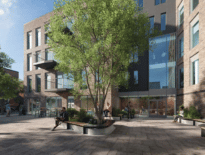Boston officials laid out a strong plan last week to make sure downtown bounces back better than it was before the pandemic. But key pieces are missing, and a significant infusion of money will likely be needed.
Chief of Planning Arthur Jemison and Chief of Economic Opportunity and Inclusion Segun Idowu are doing the right thing by trying to pull many key levers at once, attempting to bring more arts, minority businesses, office tenants and housing downtown. The neighborhood got into the mess it’s in partly because it is so heavily dependent on office uses. Its future must be multifaceted if it’s to be more resilient, more fun and more appealing to a broad swath of people in our increasingly diverse city.
And by foregrounding equity and seeing the inevitable slump in retail rents as an opportunity, Jemison and Idowu stand a good chance at helping a lot of local entrepreneurs get a big leg up in life.
But much of the plan’s success will rest on whether empty office space can be turned into housing. Realistically, growing the number of downtown residents is the only way to ensure a sustainable amount of foot traffic needed to support retail and meeting Mayor Michelle Wu’s goals of making downtown more than a 9-to-5 neighborhood. Lab conversions can certainly buttress building values and bring foot traffic, but won’t deliver on 24/7 vibrancy.
And that’s where some of Wu’s other efforts could be at cross purposes with this new downtown initiative.
The downtown revitalization plan promises expedited permitting to developments that are at least 40 percent affordable housing. A restarted downtown rezoning effort seems likely to rationalize and raise height limits for much of the area, making from-scratch residential towers possible.
City officials also say they will hire a consultant to come up with with housing conversion incentives like tax breaks. Successful examples from other cities include a 10-year property tax holiday for office-to-residential conversions that netted Philadelphia 1,800 units in two years and a $46 million fund that generated 700 units in Calgary, Alberta.
But Wu’s previous proposals to ratchet up development fees and transfer taxes seem unwise at a time when downtown is on the decline and the mayor is asking landlords to invest in costly and complicated residential conversions.
The truth of the matter is that there’s just not enough tax credits and grants out there to make sure what new housing gets built or repurposed from office space won’t be luxury product – assuming that market has a bright near-term future at all, with a glut of new units hitting the market soon.
If the mayor wants downtown to sprout more than one or two new Millennium Towers, she’s got to find a way to make it much cheaper for market-rate developers to build for the masses while building tall – no mean feat given the price of steel and the limited supply of union workers who know how to build with it.
Letters to the editor of 350 words or less may be submitted via email at editorial@thewarrengroup.com with the subject line “Letter to the Editor,” or mailed to the offices of The Warren Group.






